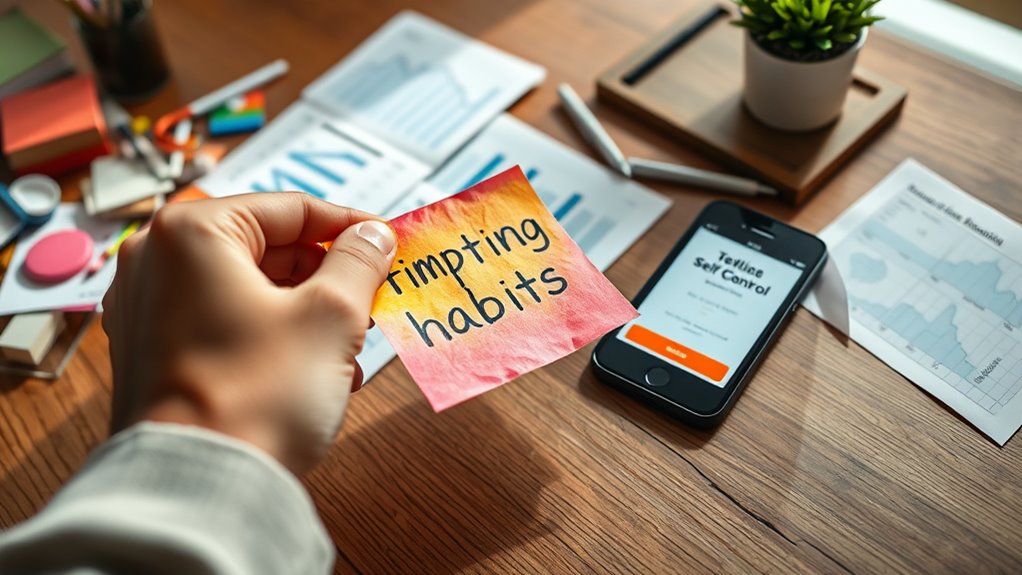A 90-day habit challenge gives you a clear timeframe to focus your efforts and build lasting change. By setting specific goals, working with an accountability partner, and tracking your progress daily, you stay motivated and consistent. This structured approach helps you see tangible results and make adjustments as needed. Keep going, and you’ll discover practical strategies to stay committed and turn new habits into long-term routines.
Key Takeaways
- Establish clear, specific goals to focus efforts during the 90-day period for effective habit formation.
- Partner with an accountability buddy to stay motivated, honest, and committed throughout the challenge.
- Track daily progress using journals, apps, or calendars to visualize growth and identify areas for improvement.
- Schedule regular check-ins to review progress, adjust strategies, and reinforce accountability and motivation.
- Maintain consistency and discipline over the 90 days to create lasting change and embed new habits into daily routines.

Beginning a 90-day habit challenge can be a powerful way to transform your routines and achieve lasting change. When you commit to a daily habit over three months, you’re giving yourself a clear timeframe to focus, build discipline, and see tangible results. One of the most effective strategies to stay on track during this journey is to leverage accountability partners. Having someone who checks in on your progress can boost your motivation and keep you honest. Whether it’s a friend, family member, or a fellow participant in a challenge, accountability partners create a sense of shared purpose that makes it harder to skip days or lose focus. You’ll find that knowing someone is rooting for you, or even just expects updates, makes it easier to stay committed.
Progress tracking is another essential element of a successful 90-day challenge. Keeping a journal, using apps, or marking a calendar helps you visualize your journey. When you track your progress daily or weekly, you gain clarity on how consistent you’ve been and where you might need to improve. Seeing your streaks grow or noticing gaps can motivate you to push through plateaus or setbacks. It also provides a sense of achievement as you witness continuous improvement, reinforcing your commitment to the habit. Incorporating habit-tracking tools can further streamline this process and enhance your motivation.
To maximize your success, establish a system that combines accountability partners and progress tracking. Share your goals with someone you trust, and set regular check-ins—whether weekly calls or messages—to discuss your progress. This accountability creates a feedback loop that keeps you honest and focused. Simultaneously, use tools like habit-tracking apps or a simple spreadsheet to record each day’s effort. This dual approach helps you stay motivated, identify patterns, and adjust your strategies if needed.
Frequently Asked Questions
How Do I Stay Motivated During the 90 Days?
To stay motivated during your 90-day challenge, focus on intrinsic motivation by reminding yourself why the habit matters to you. Find accountability partners who can encourage and challenge you along the way. Celebrate small wins to maintain momentum, and keep your goals clear and achievable. When you stay connected to your purpose and have support, you’ll find it easier to stay committed and motivated throughout the entire journey.
What if I Miss a Day or Fall Behind?
When you miss a day or fall behind, remember setbacks happen, but consistency matters most. Instead of dwelling on the slip-up, use accountability strategies like tracking your progress and sharing goals with someone. Restart promptly, refocus on your habits, and stay committed. Each setback is a chance to learn and strengthen your discipline, so keep going—your persistence builds lasting change, not perfection.
Can I Customize the Challenge to Fit My Goals?
You can absolutely customize the challenge to fit your goals. Personalization options allow you to tailor the habit, making it more relevant and engaging for you. Focus on goal alignment by adjusting tasks or milestones to match your specific objectives. This flexibility helps keep you motivated, guarantees you’re working toward what truly matters, and makes the process more achievable and enjoyable, increasing your chances of lasting success.
How Do I Track Progress Effectively?
To track your progress effectively, start with progress journaling daily. Write down what you accomplish and how you feel about it. Incorporate visual tracking tools like charts or habit trackers to see patterns over time. This combination helps you stay motivated and aware of your growth. Regularly reviewing your entries allows you to adjust your strategies and maintain momentum toward your goals.
What Are Common Pitfalls to Avoid?
Imagine trying to build a bridge without knowing where the weak spots are. That’s like avoiding common pitfalls when overcoming setbacks. You might lose motivation or stray from your goals. To stay on track, use accountability strategies like journaling or support groups. Be aware of pitfalls like neglecting progress or setting unrealistic goals. Staying vigilant helps you avoid these traps and keeps your habit-building journey steady and successful.
Conclusion
Embrace the excitement of your 90-day habit challenge and experience the power of perseverance. Remember, small steps lead to significant, lasting change. Stay steadfast, stay specific, and celebrate every success along the way. With dedication and determination, you’ll discover that discipline and desire can drive your destiny. Don’t delay—dare to develop, and watch your world transform one week at a time. Your journey to joy and growth begins with just one step today.









